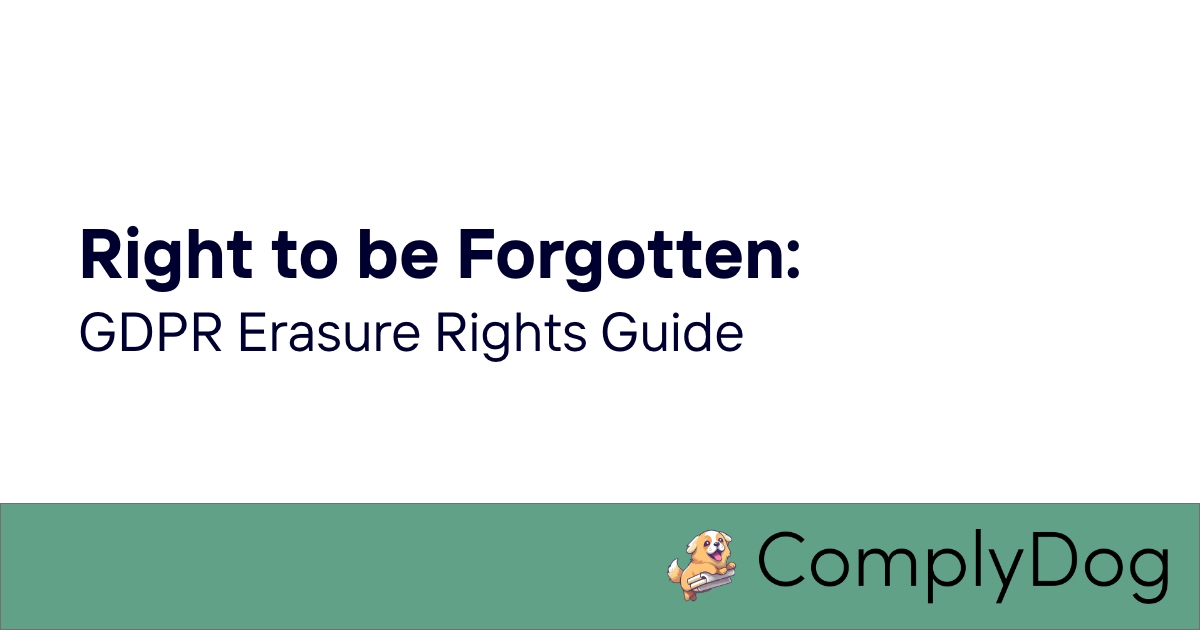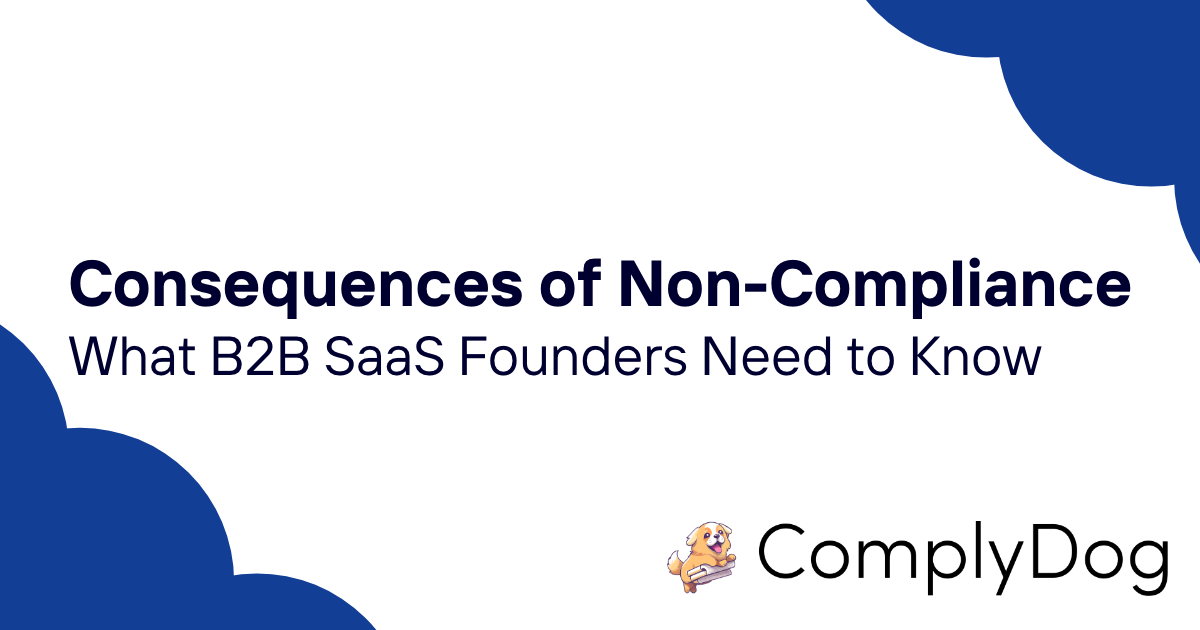The right to be forgotten, formally known as the right to erasure under GDPR Article 17, empowers individuals to request deletion of their personal data under specific circumstances. This fundamental privacy right represents one of GDPR's most significant innovations, providing individuals with meaningful control over their digital footprint while creating complex implementation challenges for organizations.
This comprehensive guide explains the legal framework, practical requirements, and technical considerations for implementing erasure rights effectively. Understanding these elements helps organizations build compliant systems that respect individual rights while maintaining legitimate business operations.
What is the Right to be Forgotten?
The right to be forgotten grants individuals the right to obtain erasure of personal data concerning them under specific circumstances defined by GDPR Article 17, representing a fundamental shift toward individual data control.
Legal Foundation and Evolution
The right to be forgotten evolved from European legal traditions emphasizing personal dignity and privacy protection:
European Court of Justice Origins: The concept gained prominence through the 2014 Google Spain case, which established principles for search result deletion and individual privacy protection.
GDPR Codification: GDPR Article 17 codifies and expands erasure rights beyond search engines to all data controllers processing personal data.
Digital Rights Framework: The right represents broader digital rights movements seeking to give individuals meaningful control over their online presence and data trails.
Balancing Test Evolution: Legal development continues refining how erasure rights balance with other fundamental rights including freedom of expression and information.
Global Influence: The concept influences privacy legislation worldwide, with variations appearing in California CCPA and other privacy frameworks.
Core Principles and Objectives
The right to be forgotten serves several fundamental privacy protection principles:
Individual Autonomy: Empowering individuals to control their personal data and digital identity throughout their lives.
Data Minimization: Supporting GDPR's data minimization principle by enabling removal of unnecessary or outdated personal data.
Purpose Limitation: Enforcing purpose limitation by requiring erasure when original processing purposes no longer apply.
Temporal Limitations: Recognizing that data processing relationships and purposes change over time, requiring mechanisms for data removal.
Dignity Protection: Protecting human dignity by enabling individuals to move beyond past events or outdated information.
Scope and Application
The right to be forgotten applies broadly across different data processing contexts:
Digital Platforms: Social media platforms, search engines, and content hosting services face significant erasure right obligations.
Business Services: Commercial services processing customer data must implement erasure capabilities for various business relationships.
Public Records: Even some public information may be subject to erasure rights depending on circumstances and legal bases.
Employment Context: Employee data may be subject to erasure rights after employment relationships end, subject to legal retention requirements.
Healthcare Data: Medical data may be subject to erasure rights while balancing public health interests and legal retention obligations.
Relationship to Other Rights
Erasure rights interact with other GDPR individual rights and broader legal frameworks:
Access Rights Integration: Individuals often exercise access rights before requesting erasure to understand what data requires deletion.
Rectification Relationship: Erasure may be preferred over rectification when personal data cannot be accurately corrected.
Restriction Alternative: Data processing restriction may serve as alternative to erasure when deletion is not technically feasible.
Portability Coordination: Data portability and erasure rights may be exercised together during service transitions.
Objection Rights: Successful objections to processing may lead to erasure requirements when processing cannot continue lawfully.
GDPR Erasure Rights Legal Framework
GDPR Article 17 establishes specific grounds for erasure while balancing individual rights with legitimate interests in data retention and processing.
Statutory Erasure Grounds
GDPR identifies six specific circumstances that trigger erasure obligations:
Purpose Fulfillment: Personal data must be erased when it's no longer necessary for the original purposes for which it was collected or processed.
Consent Withdrawal: When individuals withdraw consent and no other legal basis exists for continued processing, erasure becomes mandatory.
Unlawful Processing: Personal data processed unlawfully must be erased to remedy the violation and prevent continued harm.
Legal Compliance: Erasure may be required to comply with legal obligations applicable to the data controller.
Child Data Protection: Special provisions require erasure of personal data collected from children when they were unable to provide valid consent.
Objection Success: When individuals successfully object to processing based on legitimate interests or direct marketing, erasure may be required.
Erasure Timeline Requirements
GDPR establishes strict timelines for responding to erasure requests:
Without Undue Delay: Organizations must erase personal data "without undue delay" when legal grounds exist, typically interpreted as immediately upon verification.
One Month Response: Organizations have one month to inform individuals about erasure actions or explain why erasure cannot be completed.
Extension Provisions: Complex requests may qualify for two-month extensions with appropriate justification and individual notification.
Immediate Action: When erasure grounds clearly exist, organizations should act immediately rather than waiting for deadline expiration.
Documentation Requirements: Organizations must document erasure actions and rationale for compliance verification and accountability.
Verification and Authentication
Protecting against fraudulent erasure requests requires appropriate verification procedures:
Identity Verification: Reasonable measures to verify the identity of individuals making erasure requests without creating excessive barriers.
Authority Confirmation: Verification that requestors have authority to request erasure, particularly for requests involving children or deceased individuals.
Request Scope: Clear understanding of what specific data the individual wants erased and verification that the request covers appropriate data.
Legitimate Interest: Assessment of whether the individual has legitimate reasons for requesting erasure.
Fraud Prevention: Appropriate measures to prevent fraudulent requests that could harm individuals or undermine legitimate data processing.
Communication and Transparency
Effective erasure right implementation requires clear communication throughout the process:
Request Acknowledgment: Prompt acknowledgment of erasure requests with clear explanation of next steps and timelines.
Progress Updates: Regular communication about request processing progress, particularly for complex requests requiring investigation.
Completion Notification: Clear notification when erasure is completed or explanation when erasure cannot be performed.
Appeal Information: Information about appeal or complaint procedures when individuals disagree with erasure decisions.
Documentation Provision: Appropriate documentation of erasure actions for individual records and compliance verification.
When Erasure Rights Apply
Understanding specific circumstances that trigger erasure rights helps organizations implement appropriate procedures while avoiding unnecessary data deletion.
No Longer Necessary Standard
The "no longer necessary" standard represents the most common ground for erasure requests:
Purpose Assessment: Systematic evaluation of whether personal data remains necessary for the original collection and processing purposes.
Business Evolution: Recognition that business purposes and data needs change over time, requiring ongoing necessity assessments.
Functional Requirements: Assessment of whether specific business functions still require particular personal data for legitimate operations.
Legal Obligations: Consideration of legal retention requirements that may override necessity-based erasure obligations.
Proportionality Analysis: Balancing continued data retention against individual privacy interests and erasure requests.
Consent-Based Erasure
Consent withdrawal creates specific erasure obligations with important considerations:
Sole Legal Basis: Erasure becomes mandatory when consent was the only legal basis and individuals withdraw consent.
Alternative Basis Assessment: Evaluation of whether other legal bases might justify continued processing after consent withdrawal.
Granular Consent: Consideration of granular consent withdrawals that may require partial rather than complete erasure.
Service Impact: Assessment of how consent withdrawal and related erasure affects service delivery and customer relationships.
Re-consent Possibilities: Understanding when and how individuals might provide fresh consent for continued processing.
Unlawful Processing Remediation
Erasure serves as remedy for unlawful processing situations:
Legal Basis Failures: When processing lacks valid legal basis, erasure helps remedy the violation and prevent continued harm.
Security Breach Response: Data breaches may trigger erasure obligations when continued processing poses unacceptable risks.
Compliance Violations: Other GDPR violations may require erasure as part of comprehensive remediation efforts.
Third-Party Violations: When vendors or partners violate processing agreements, erasure may be required to limit exposure.
Regulatory Orders: Data protection authorities may order erasure as enforcement action for compliance violations.
Child Data Special Provisions
Children's data receives enhanced protection with specific erasure considerations:
Capacity Assessment: Recognition that children may lack capacity to provide valid consent for data processing.
Retrospective Requests: Adults may request erasure of data collected when they were children and unable to provide valid consent.
Parental Authority: Consideration of parental rights and authority over children's data and erasure requests.
Age Verification: Challenges in verifying ages and consent validity for historical data collection.
Educational Context: Special considerations for educational data and long-term record-keeping requirements.
As discussed in our Data Protection Officer guide, DPOs often oversee erasure right implementation and provide guidance on complex erasure scenarios.
Exceptions to the Right to be Forgotten
GDPR Article 17(3) establishes specific exceptions where erasure rights do not apply, balancing individual privacy with other fundamental rights and legitimate interests.
Freedom of Expression and Information
The most significant exception protects freedom of expression and information rights:
Journalistic Purposes: Media organizations may retain personal data necessary for journalistic activities and news reporting.
Academic Expression: Academic freedom protections may override erasure rights for research and scholarly publications.
Literary and Artistic Works: Creative works incorporating personal data may be protected from erasure requirements.
Historical Documentation: Historical records and documentation may warrant protection from erasure for cultural and educational value.
Public Interest Information: Information serving public interests may override individual erasure rights in specific circumstances.
Legal Compliance Requirements
Legal obligations may prevent erasure even when individuals request deletion:
Statutory Retention: Laws requiring retention of specific types of data for defined periods override erasure rights.
Regulatory Obligations: Financial, healthcare, and other regulatory requirements may mandate data retention despite erasure requests.
Tax and Accounting: Business records required for tax and accounting purposes typically cannot be erased during legal retention periods.
Employment Law: Employment records may be protected from erasure due to legal obligations for workplace safety and discrimination prevention.
Contractual Obligations: Some contractual obligations may require data retention that conflicts with erasure requests.
Public Health and Safety
Public interest considerations may override individual erasure rights in specific circumstances:
Public Health: Health data may be protected from erasure when necessary for public health monitoring and disease prevention.
Safety Monitoring: Safety-related data may warrant retention to prevent harm to individuals or the public.
Research Interests: Scientific research serving public interests may justify data retention despite erasure requests.
Statistical Purposes: Data serving important statistical functions may be protected from erasure while maintaining anonymization.
Emergency Response: Data necessary for emergency response and disaster management may warrant retention.
Legal Claims and Defense
Legitimate interests in legal protection may override erasure rights:
Litigation Preservation: Data necessary for establishing, exercising, or defending legal claims may be retained during relevant limitation periods.
Dispute Resolution: Information relevant to ongoing disputes may be protected from erasure until resolution.
Regulatory Defense: Data necessary for defending against regulatory actions may warrant retention despite erasure requests.
Investigation Support: Information supporting legitimate investigations may be protected from premature erasure.
Evidence Preservation: Legal evidence may require retention to ensure fair legal proceedings and dispute resolution.
Balancing Test Application
Applying exceptions requires careful balancing of competing interests and rights:
Proportionality Assessment: Evaluating whether data retention is proportionate to the legitimate interests being protected.
Least Intrusive Means: Considering whether partial erasure or data minimization could satisfy both erasure rights and retention needs.
Temporal Limitations: Assessing how long exceptions should apply and when erasure obligations might resume.
Individual Impact: Considering specific harm or benefit to individuals from data retention or erasure.
Public Interest Evaluation: Weighing public benefits against individual privacy interests in specific circumstances.
Implementing Erasure Procedures
Effective erasure right implementation requires systematic procedures that ensure compliant processing while maintaining operational efficiency and data integrity.
Request Processing Workflow
Systematic workflows ensure consistent and compliant erasure request handling:
Request Reception: Multiple channels for receiving erasure requests including web forms, email, phone, and postal mail.
Initial Assessment: Rapid evaluation of request validity, identity verification, and preliminary erasure ground assessment.
Data Discovery: Comprehensive identification of all personal data associated with the requesting individual across organizational systems.
Legal Analysis: Detailed analysis of applicable erasure grounds and potential exceptions or limitations.
Stakeholder Coordination: Coordination with legal, technical, and business teams to evaluate erasure implications and requirements.
Identity Verification Procedures
Protecting against fraudulent requests while enabling legitimate erasure requires balanced verification approaches:
Reasonable Verification: Implementing verification measures that are reasonable given the circumstances and potential risks.
Document-Based Verification: Accepting appropriate identity documents while avoiding excessive documentation requirements.
Account-Based Verification: Using existing account authentication for individuals with established customer relationships.
Alternative Verification: Providing alternative verification methods for individuals who cannot provide standard documentation.
Fraud Prevention: Implementing measures that prevent fraudulent requests while maintaining accessibility for legitimate requestors.
Data Location and Discovery
Comprehensive data discovery ensures complete erasure implementation:
System Inventory: Maintaining current inventories of all systems and databases that might contain personal data.
Search Capabilities: Implementing search functionality that can locate personal data across different systems and data formats.
Backup Systems: Addressing personal data in backup systems, archives, and disaster recovery environments.
Third-Party Systems: Coordinating erasure across vendor systems and third-party platforms that process personal data.
Data Lineage Tracking: Understanding how personal data flows through systems to ensure complete erasure implementation.
Technical Implementation
Technical erasure implementation requires attention to both immediate deletion and long-term data management:
Secure Deletion: Using technical methods that securely delete data rather than simply marking it as deleted.
Database Management: Implementing database procedures that properly remove personal data while maintaining referential integrity.
File System Cleanup: Ensuring file systems and storage devices properly delete personal data including temporary and cached files.
Encryption Key Management: Considering cryptographic erasure through encryption key deletion when appropriate and secure.
Audit Logging: Maintaining appropriate logs of erasure activities for compliance verification while avoiding retention of erased data.
As outlined in our cookie consent banner guide, erasure rights often interact with consent management systems and require coordination across different privacy controls.
Technical Erasure Requirements
Technical implementation of erasure rights requires sophisticated approaches that ensure complete data removal while maintaining system integrity and business continuity.
Data Architecture Considerations
Effective erasure requires understanding and planning for data architecture implications:
Relational Database Design: Designing database schemas that enable efficient personal data identification and removal without compromising data integrity.
Data Normalization: Balancing data normalization with erasure requirements to enable complete personal data removal.
Foreign Key Management: Handling foreign key relationships and referential integrity when erasing personal data from relational systems.
Index Management: Ensuring personal data removal includes all database indexes and cached query results.
Transaction Logging: Managing transaction logs and database recovery systems that might retain erased personal data.
Storage System Implementation
Different storage technologies require specific approaches for effective erasure:
Traditional File Systems: Implementing secure deletion procedures that overwrite data rather than simply marking files as deleted.
Cloud Storage: Understanding cloud provider deletion policies and ensuring complete data removal from distributed storage systems.
Backup and Archive Systems: Coordinating erasure across backup systems while maintaining necessary business continuity capabilities.
Data Warehouses: Managing personal data erasure in data warehouse environments while preserving analytical capabilities.
Content Delivery Networks: Ensuring personal data removal from content delivery networks and edge caching systems.
Secure Deletion Techniques
Technical deletion must ensure data cannot be recovered through forensic or technical means:
Overwriting Methods: Using multiple-pass overwriting techniques that make data recovery technically impossible.
Cryptographic Erasure: Deleting encryption keys to render encrypted personal data permanently inaccessible.
Physical Destruction: Appropriate physical destruction of storage media when necessary for complete data elimination.
Solid State Drive Considerations: Understanding SSD-specific deletion requirements and limitations for secure data erasure.
Cloud Provider Coordination: Working with cloud providers to ensure their deletion procedures meet security and compliance requirements.
System Integration Challenges
Erasure implementation must address complex system integration scenarios:
API Coordination: Coordinating erasure across multiple systems through API calls and data synchronization.
Real-Time Systems: Managing erasure in real-time processing systems without disrupting ongoing operations.
Distributed Architectures: Implementing erasure across microservices and distributed system architectures.
Legacy System Integration: Addressing erasure requirements in legacy systems that weren't designed for personal data deletion.
Third-Party Integration: Coordinating erasure with external systems and vendor platforms that process personal data.
Validation and Verification
Technical implementation requires verification that erasure was completed successfully:
Deletion Confirmation: Technical verification that personal data was successfully removed from all targeted systems.
Search Validation: Confirming that searches for erased personal data return no results across all relevant systems.
Backup Verification: Verifying that backup and archive systems properly handle erased personal data.
Recovery Testing: Testing disaster recovery procedures to ensure they don't restore erased personal data.
Audit Trail Maintenance: Maintaining appropriate evidence of erasure activities without retaining the erased personal data.
Third-Party Data Sharing Considerations
Erasure rights create complex obligations when personal data has been shared with third parties, requiring systematic approaches to downstream deletion.
Sharing Notification Requirements
GDPR requires notifying third parties about erasure obligations under specific circumstances:
Reasonable Steps: Taking reasonable steps to inform third parties who have received personal data about erasure obligations.
Practical Considerations: Balancing notification obligations with practical limitations and costs of comprehensive third-party communication.
Link Removal: Specifically notifying parties about requests to erase links to or copies of personal data.
Public Data Considerations: Special obligations when personal data has been made public before erasure requests.
Technical Implementation: Using technical measures to communicate erasure requirements to automated systems and data processing networks.
Vendor and Processor Coordination
Data processing relationships require coordinated erasure implementation:
Processing Agreement Updates: Ensuring data processing agreements include clear erasure obligations and procedures.
Vendor Notification: Systematic notification of vendors and processors about erasure requirements affecting shared personal data.
Compliance Verification: Verifying that vendors and processors properly implement erasure requirements within required timeframes.
Cascade Requirements: Ensuring vendor erasure obligations extend to their sub-processors and business partners.
Documentation Requirements: Maintaining appropriate documentation of vendor erasure compliance for accountability purposes.
Public Information Challenges
Erasure becomes more complex when personal data has been made publicly available:
Search Engine Coordination: Working with search engines to remove links to erased personal data from search results.
Social Media Platforms: Coordinating with social media platforms to remove personal data from public posts and profiles.
News Media Engagement: Engaging with news organizations about erasure requests while respecting freedom of expression rights.
Archive Management: Addressing personal data in web archives and historical collections that may preserve erased information.
Viral Content Issues: Managing situations where personal data has been widely shared or gone viral before erasure requests.
Cross-Border Erasure
International data sharing creates additional complexity for erasure implementation:
Jurisdictional Coordination: Coordinating erasure across different legal jurisdictions with varying privacy requirements.
Adequacy Decision Impact: Understanding how adequacy decisions affect erasure obligations for international data transfers.
Legal Mechanism Requirements: Ensuring international data transfer mechanisms include appropriate erasure provisions.
Enforcement Limitations: Recognizing practical limitations in enforcing erasure requirements across international boundaries.
Reciprocal Arrangements: Developing reciprocal arrangements with international partners for mutual erasure assistance.
Erasure Rights Compliance Tools
Effective erasure rights implementation requires specialized tools and technologies that automate complex processes while ensuring comprehensive compliance.
Automated Request Processing
Technology solutions can streamline erasure request handling while maintaining compliance quality:
Request Management Systems: Comprehensive platforms that manage erasure requests from initial receipt through completion verification.
Identity Verification Tools: Automated tools that verify requester identity while maintaining appropriate security and accessibility.
Workflow Automation: Automated workflows that route erasure requests to appropriate teams and track processing progress.
Timeline Management: Systems that automatically track deadlines and send alerts to ensure timely completion of erasure requests.
Communication Automation: Automated communication tools that keep requestors informed about processing progress and completion.
Data Discovery and Management
Comprehensive data discovery tools enable effective erasure implementation:
Personal Data Discovery: Automated tools that locate personal data across complex organizational systems and databases.
Data Lineage Tracking: Systems that track how personal data flows through organizational processes and technology systems.
Relationship Mapping: Tools that identify relationships between different data elements to ensure comprehensive erasure.
Cross-System Search: Capabilities that search for personal data across multiple systems and data formats simultaneously.
Backup Integration: Tools that address personal data in backup systems and archived data repositories.
Erasure Execution Tools
Technical tools must safely and completely implement erasure decisions:
Secure Deletion Software: Specialized software that ensures personal data cannot be recovered after deletion.
Database Management: Tools that manage personal data erasure in complex database environments while maintaining referential integrity.
API Integration: Systems that coordinate erasure across multiple platforms and applications through API connections.
Verification Systems: Tools that verify successful erasure completion across all relevant systems and storage locations.
Audit Documentation: Systems that document erasure activities and maintain appropriate evidence for compliance verification.
Compliance Monitoring and Reporting
Ongoing monitoring ensures sustained compliance with erasure rights obligations:
Performance Dashboards: Real-time dashboards that track erasure request volumes, processing times, and completion rates.
Compliance Metrics: Key performance indicators that measure erasure rights compliance effectiveness and identify improvement opportunities.
Audit Support: Systems that generate appropriate documentation for internal audits and regulatory examinations.
Trend Analysis: Analytics that identify patterns in erasure requests and help optimize processing procedures.
Regulatory Reporting: Tools that support regulatory reporting requirements and data protection authority communications.
Building effective erasure rights compliance requires combining legal understanding with technical implementation and systematic process management. The most successful approaches treat erasure rights as fundamental privacy protections that require comprehensive organizational support rather than isolated technical solutions.
For organizations seeking to implement comprehensive erasure rights alongside broader privacy compliance programs, integrated platforms often provide better coordination and effectiveness than standalone erasure tools that operate independently from other privacy controls.
Ready to implement comprehensive erasure rights management as part of systematic privacy compliance? Use ComplyDog and get integrated privacy management that includes automated erasure request processing, comprehensive data discovery, and coordinated privacy rights management that ensures consistent compliance across all individual rights while maintaining operational efficiency and regulatory accountability.


















